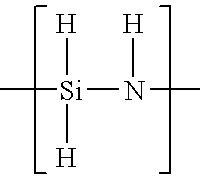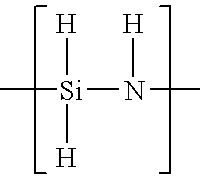Anti-staining coating solution comprising inorganic polysilazane
a technology of inorganic polysilazane and coating solution, which is applied in the direction of coatings, biocides, biocide, etc., can solve the problems of easy dust and dust accumulation on the body, easy water washing away, and difficulty in adhesion of fouling components to the surface of the body
- Summary
- Abstract
- Description
- Claims
- Application Information
AI Technical Summary
Benefits of technology
Problems solved by technology
Method used
Image
Examples
production example 1
(Production of the Inorganic Polysilazane)
[0050] A gas inlet tube, a mechanical stirrer and a Dewar condenser were fit into a four-necked flask with an internal volume of 300 ml. The inside of the reactor was replaced by dry deoxygenated nitrogen, and then 150 ml of dry degassed pyridine was introduced into the four-necked flask and cooled on ice. Then, 16.1 g dichlorosilane was added thereto over 50 minutes, to form a white solid adduct (SiH.sub.2Cl.sub.2.2Py). The reaction mixture was cooled on ice under vigorous stirring and bubbled over 1 hour with a mixture of a nitrogen gas and 10.9 g ammonia previously purified by passage through a soda lime tube and an active carbon tube. After the reaction was finished, the solid product was removed by centrifugation and subsequent filtration. By removing the solvent from the filtrate under reduced pressure (50.degree. C., 5 mmHg, 2 hours), 5.52 g glassy solid polysilazane was obtained. The molecular weight of the polysilazane determined by...
example 1
[0051] 0.5 part by weight of the inorganic polysilazane obtained in Production Example 1 and 0.02 part by weight of DMPP (catalyst) were dissolved in a solvent consisting of 1.98 parts by weight of xylene and 97.5 parts by weight of Pegasol AN45 (Mobil Sekiyu Corp.), to give an anti-fouling coating solution for automobile bodies and wheels.
[0052] The coating solution was coated by spraying with a spray gun onto a coated steel plate in such an amount as to give a coating of 0.2 .mu.m in thickness after conversion into silica. After drying, the coating was examined in an outdoor exposure test, and the change in contact angle was observed, to give the results in Table 1.
7TABLE 1 Number of outdoor exposure days 3 6 1 (days) 0 7 14 21 28 months months year Contact angle 65 41 23 16 11 10 9 10 (degrees)
[0053] As can be seen from Table 1, formation of a silica coating gradually proceeded, and 2 weeks later, a hydrophilic coating had been almost formed, and by this hydrophilic silica coatin...
example 2
[0056] One part by weight of the inorganic polysilazane obtained in Production Example 1 and 0.04 part by weight of DMPP (catalyst) were dissolved in a solvent consisting of 98.96 parts by weight of Pegasol AN45 (Mobil Sekiyu Corp.), to give an anti-fouling coating solution for dentures.
[0057] This coating solution was applied by a spray gun onto the whole of dentures to form a silica coating of 0.3 .mu.m in thickness thereon. The coating was converted completely into silica by drying it at 45.degree. C. for 60 minutes in an oven and subsequent treatment for 12 hours under the conditions of 40.degree. C. and 90% relative humidity in a high-temperature high-humidity apparatus. A hydrophilic and dense silica coating was formed on the surface of the dentures, and when the dentures were used, the coating was not deteriorated, and fouling could be easily washed away with water, and no smell was generated.
PUM
| Property | Measurement | Unit |
|---|---|---|
| temperature | aaaaa | aaaaa |
| temperature | aaaaa | aaaaa |
| thickness | aaaaa | aaaaa |
Abstract
Description
Claims
Application Information
 Login to View More
Login to View More - R&D
- Intellectual Property
- Life Sciences
- Materials
- Tech Scout
- Unparalleled Data Quality
- Higher Quality Content
- 60% Fewer Hallucinations
Browse by: Latest US Patents, China's latest patents, Technical Efficacy Thesaurus, Application Domain, Technology Topic, Popular Technical Reports.
© 2025 PatSnap. All rights reserved.Legal|Privacy policy|Modern Slavery Act Transparency Statement|Sitemap|About US| Contact US: help@patsnap.com


